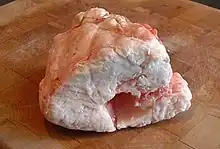Suet
Suet is the raw, hard fat of beef, lamb or mutton found around the loins and kidneys.

Suet has a melting point of between 45 °C and 50 °C (113 °F and 122 °F) and congelation between 37 °C and 40 °C (98.6 °F and 104 °F). Its high smoke point makes it ideal for deep frying and pastry production.

The primary use of suet is to make tallow, although it is also used as an ingredient in cooking, especially in traditional baked puddings, such as British Christmas pudding. Suet is made into tallow in a process called rendering, which involves melting fats and extended simmering, followed by straining, then cooling. The entire process is then usually repeated to refine the product.
Etymology
The word suet /ˈs(j)uːɪt/ is derived from Anglo-Norman siuet, suet, from Old French sieu, seu, from Latin sēbum ('tallow', 'grease', 'hard animal fat').[1] Sebum is from the Proto-Indo-European root *seyb- ('pour out, trickle'), so it shares a root with sap and soap.[2][3]
Trade
In the 17th century economy of the Viceroyalty of Peru, Chile's husbandry and agriculture based economy had a peripheral role exporting mainly suet, jerky and leather to the other provinces of the viceroyalty. The importance of this trade led Chilean historian Benjamín Vicuña Mackenna to label the 17th century the century of suet (Spanish: siglo del sebo).[4]
Cuisine
| Nutritional value per 100 g (3.5 oz) | |
|---|---|
| Energy | 3,573 kJ (854 kcal) |
0 g | |
94 g | |
| Saturated | 52 g |
| Monounsaturated | 32 g |
| Polyunsaturated | 3 g |
1.50 g | |
| Minerals | Quantity %DV† |
| Zinc | 2% 0.22 mg |
| Other constituents | Quantity |
| Cholesterol | 68 mg |
| Selenium | 0.2 mcg |
Fat percentage can vary. | |
| |
| †Percentages are roughly approximated using US recommendations for adults. Source: USDA FoodData Central | |
Suet is found in several traditional British dishes. Suet pastry is soft in contrast to the crispness of shortcrust pastry, which makes it ideal for certain sweet and savoury dishes. Suet is most widely used in sweet British baked puddings, such as jam roly-poly and spotted dick. Savoury dishes include dumplings, which are made using a mixture of suet, flour and water rolled into balls that are added to stews during the final twenty minutes or so of cooking. In the savoury dish steak and kidney pie or steak and kidney pudding, a bowl is lined with a suet pastry, the meat is placed inside and a lid of suet pastry tightly seals the meat. The pudding is then steamed for approximately four hours before serving. Suet is also an ingredient of traditional mincemeat, which is also referred to as 'fruit mince'.
As it is the fat from around the kidneys, the connective tissue, blood and other non-fat content must be removed. It then must be coarsely grated. It must be refrigerated prior to use and used within a few days of purchase, similar to raw meat.
Due to its high energy content, cold weather explorers use suet to supplement the high daily energy requirement needed to travel in such climates. Typically the energy requirement is around 5,000–6,000 Cal per day for sledge hauling or dog-sled travelling.[5] Suet is added to food rations to increase the fat content and help meet this high energy requirement.
| Type of fat | Total fat (g) | Saturated fat (g) | Monounsaturated fat (g) | Polyunsaturated fat (g) | Smoke point |
|---|---|---|---|---|---|
| Butter[6] | 80–88 | 43–48 | 15–19 | 2–3 | 150 °C (302 °F)[7] |
| Canola oil[8] | 100 | 6–7 | 62–64 | 24–26 | 205 °C (401 °F)[9][10] |
| Coconut oil[11] | 99 | 83 | 6 | 2 | 177 °C (351 °F) |
| Corn oil[12] | 100 | 13–14 | 27–29 | 52–54 | 230 °C (446 °F)[7] |
| Lard[13] | 100 | 39 | 45 | 11 | 190 °C (374 °F)[7] |
| Peanut oil[14] | 100 | 17 | 46 | 32 | 225 °C (437 °F)[7] |
| Olive oil[15] | 100 | 13–19 | 59–74 | 6–16 | 190 °C (374 °F)[7] |
| Rice bran oil | 100 | 25 | 38 | 37 | 250 °C (482 °F)[16] |
| Soybean oil[17] | 100 | 15 | 22 | 57–58 | 257 °C (495 °F)[7] |
| Suet[18] | 94 | 52 | 32 | 3 | 200 °C (392 °F) |
| Ghee[19] | 99 | 62 | 29 | 4 | 204 °C (399 °F) |
| Sunflower oil[20] | 100 | 10 | 20 | 66 | 225 °C (437 °F)[7] |
| Sunflower oil (high oleic) | 100 | 12 | 84[9] | 4[9] | |
| Vegetable shortening [21] | 100 | 25 | 41 | 28 | 165 °C (329 °F)[7] |
Availability
Pre-packaged suet sold in supermarkets is dehydrated suet. It is mixed with flour to make it stable at room temperature, requiring some care when using it for recipes calling for fresh suet, as the proportions of flour to fat can change. Most modern processed recipes stipulate packaged suet.
Also available is vegetable suet, which is made from refined vegetable oil.[22]
Cultural and religious restrictions
Consumption of suet is forbidden according to the Jewish religion and it was reserved for ritual altar sacrifices. This restriction only applies to those animals which were used for sacrifices, and thus does not include wild animals such as deer. Maimonides in his book Guide To The Perplexed, writes that one of the ideas behind this commandment is that the Torah wants to teach people to develop the discipline to avoid very tasty foods that are unhealthy.
Bird feed

Woodpeckers, goldfinches, juncos, cardinals, thrushes, jays, kinglets, bluebirds, chickadees, nuthatches, wrens, and starlings prefer suet-based bird feeders.[23]
Bird feed is commonly used in the form of cakes of suet, which can be made with other solid fats, such as lard. Rolled oats, bird seed, cornmeal, raisins, and unsalted nuts are often incorporated into the suet cakes.[24]
Suet-based recipes
- Christmas pudding
- Clangers
- Clootie dumplings
- Dumplings
- Haggis
- Jamaican patty
- Kishka/Kishke
- Mincemeat
- Pemmican
- Rag pudding
- Spotted dick
- Steak and kidney pudding
- Suet pudding
- Sussex pond pudding
- Suet-crust pastry
- Windsor pudding
References
- Gilleland, Jeannie Rideout (1980). "Anglo-Norman Siuet, Source of English Suet". Zeitschrift für französische Sprache und Literatur. 90 (3): 248–250. JSTOR 40616857.
- Kirkpatrick, Andy (2010). The Routledge Handbook of World Englishes. Routledge. ISBN 978-1136954566. Archived from the original on 2021-12-06. Retrieved 2020-11-03 – via Google Books.
- "Archived copy" (PDF). Archived (PDF) from the original on 2019-12-21. Retrieved 2019-12-21.
{{cite web}}: CS1 maint: archived copy as title (link) - {es icon} [Sergio Villalobos|Villalobos, Sergio]; Retamal Ávila, Julio and Serrano, Sol. 2000. Historia del pueblo Chileno. Vol 4. p. 154.
- Nutritional Requirements in Cold Climates Archived 2015-10-13 at the Wayback Machine, Rodahl, Kaare; JN - The Journal of Nutrition
- "Butter, stick, salted, nutrients". FoodData Central. USDA Agricultural Research Service. Retrieved 24 April 2020.
- The Culinary Institute of America (2011). The Professional Chef (9th ed.). Hoboken, New Jersey: John Wiley & Sons. ISBN 978-0-470-42135-2. OCLC 707248142.
- "Oil, canola, nutrients". FoodData Central. USDA Agricultural Research Service. Retrieved 24 April 2020.
- "Nutrient database, Release 25". United States Department of Agriculture.
- Katragadda HR, Fullana A, Sidhu S, Carbonell-Barrachina ÁA (2010). "Emissions of volatile aldehydes from heated cooking oils". Food Chemistry. 120: 59. doi:10.1016/j.foodchem.2009.09.070.
- "Oil, coconut, nutrients". FoodData Central. USDA Agricultural Research Service. Retrieved 24 April 2020.
- "Oil, corn, nutrients". FoodData Central. USDA Agricultural Research Service. Retrieved 24 April 2020.
- "Lard, nutrients". FoodData Central. USDA Agricultural Research Service. Retrieved 24 April 2020.
- "Peanut oil, nutrients". FoodData Central. USDA Agricultural Research Service. Retrieved 24 April 2020.
- "Oil, olive, extra virgin, nutrients". FoodData Central. USDA Agricultural Research Service. Retrieved 24 April 2020.
- "Rice Bran Oil FAQ's". AlfaOne.ca. Archived from the original on 2014-09-27. Retrieved 2014-10-03.
- "Oil, soybean, nutrients". FoodData Central. USDA Agricultural Research Service. Retrieved 24 April 2020.
- "Beef, variety meats and by-products, suet, raw, nutrients". FoodData Central. USDA Agricultural Research Service. Retrieved 24 April 2020.
- "Nutrition data for Butter oil, anhydrous (ghee) per 100 gram reference amount"". FoodData Central. USDA Agricultural Research Service. Retrieved 25 July 2021.
- "Sunflower oil, nutrients". FoodData Central. USDA Agricultural Research Service. Retrieved 24 April 2020.
- "Shortening, vegetable, nutrients". FoodData Central. USDA Agricultural Research Service. Retrieved 24 April 2020.
- "Vegetable suet". gourmetsleuth.com. Retrieved 17 November 2022.
- "Suet | Baltimore County Library System". Archived from the original on 2008-04-18. Retrieved 2018-03-12.
- "Attractwildbirds.com". Archived from the original on September 5, 2010.